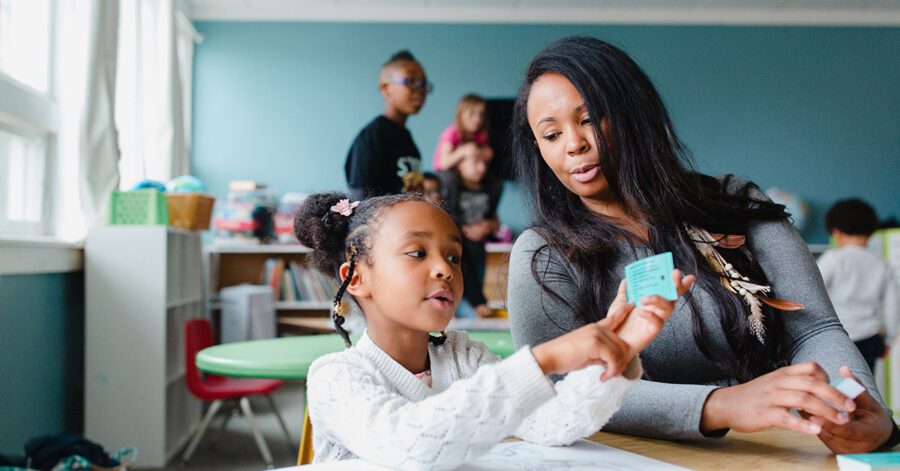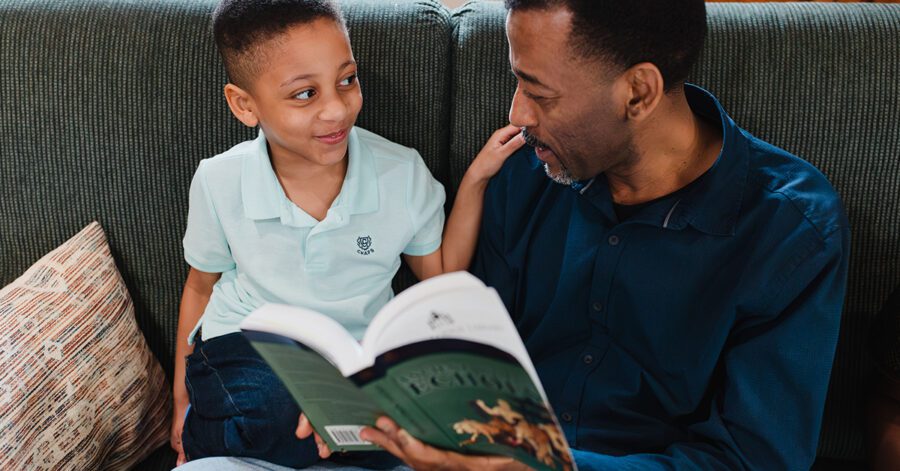Are you interested in classical education but not sure how educational philosophy translates into practical application?
What is classical education, anyway? The heart of the classical model is not just about what students learn but how they learn.
The medieval Trivium—grammar, dialectic, and rhetoric—provides a timeless framework for developing knowledge, understanding, and wisdom.
Name like Adam. Question like Jesus. Persuade like Paul.
These three simple phrases beautifully summarize the three arts of the Trivium. Students, whether children or parents, grow in these arts by practicing 15 classical education skills.
In this blog, we’ll break down these skills into practical, approachable habits you can implement in your homeschool. Discover how these foundational education skills bridge the gap between theory and practice, helping your children flourish academically, spiritually, and personally.
Name Like Adam: Embracing the Art of Grammar
The first task God gave Adam in the Garden of Eden was to name the animals.
Here is a peek into man’s first lesson: “And out of the ground the Lord God formed every beast of the field, and every fowl of the air, and brought them unto Adam to see what he would call them: and whatsoever Adam called every living creature, that was the name thereof.” (Gen. 2:19).
The task of naming prepared Adam to know the animals and to care for them. As homeschool families, we enter into relationship with God’s Word and His World by naming.
Question Like Jesus: Mastering the Art of Dialectic
When Jesus taught his disciples, He often asked questions to broaden or correct their thinking. The most important question He asked them (the one He is still asking us today) was, “But whom say ye that I am?” (Matt. 16:15).
The disciples, good Jewish men, had lots of information about the Messiah from their memorization of Scripture, but they needed to understand what the prophecies about the Messiah really meant. They needed to be able to correctly answer His question about His identity.
As homeschool families, we broaden and correct our thinking about God’s Word and His World by asking questions.
Persuade Like Paul: Perfecting the Art of Rhetoric
Once the disciples understood who Jesus was (see Luke 24), He promised to send them the Holy Spirit and to send them out into their ministry of sharing the Gospel with the world.
In the Apostle Paul’s ministry, he used the art of rhetoric to reveal Christ to his audience. On Mars Hill, he said, “For as I passed by, and beheld your devotions, I found an altar with this inscription, To the Unknown God. Whom therefore ye ignorantly worship, him declare I unto you.” (Acts 17:23)
As homeschool families, we learn to use the best words to persuade our audiences so that they may know the truth about God’s Word and His World.
Let us dive in and examine the 15 classical education skills of learning tied to the arts of grammar, dialectic, and rhetoric.
The Five Core Habits of Grammar
The art of grammar is the study of language. Language could refer to English, Latin, math, or the sciences, to name just a few.
To become proficient in grammar, we practice the Five Core Habits of Grammar:
- Naming
- Attending
- Memorizing
- Expressing
- Storytelling
Naming: Expanding Vocabulary Through Experiences
Naming allows us to develop vocabulary through interaction. For example, a family might be gathered around the dining room table practicing handwriting when a bird alights on the fountain in the window. The child shouts, “Look, Mommy, a bird!” Mom swivels around in the chair and responds, “Yes. That’s a red-breasted robin.”
Attending: Focusing on Details with Careful Observation
Attending encourages differentiating details through sensory focus. The family could stop and talk about the difference in color between his back feathers and chest feathers. The family could listen to the sounds he is making as he bathes in their fountain.
Memorizing: Strengthening Recall Through Practice
Memorizing assists us in retaining information through repetition. The family might take a few seconds to recall and recite the types of animals: “fish, amphibians, mammals, reptiles, and birds.”
Expressing: Bring Ideas to Life Through Creative Action
Expressing allows us to demonstrate ideas through activity. Our imaginary family could take a few minutes together to sketch a picture of the robin in the fountain.
Storytelling: Sharing Experiences through Narratives
Finally, Storytelling allows us to recount events through narration.
The family might pause to read a story like “The Young Robin Who Was Afraid to Fly” from New World Echoes and discuss times when they were afraid to try something new. Or, one of the children might tell Dad the story of the robin who interrupted handwriting and explain to him how they returned to school.
Learning about these five skills equips parents to build knowledge together.
The Five Common Topics of Dialectic
The art of dialectic is the study of ideas. We move toward proficiency in dialectic by practicing The Five Common Topics.
From Challenge B on, my oldest was very interested in debate. Unfortunately, his zeal extended to matters that were not really up for discussion. When he was about fourteen, he presented me with a very impassioned argument about why putting clean laundry in the dresser was a waste of time. I invited him to practice his thinking skills on this idea.
Definition: Understanding the Meaning Behind Words
I asked him to give me a definition of a dresser. After some thinking, we were able to agree that it is a piece of furniture with drawers designed to store clothes.
Comparison: Exploring Similarities and Differences
Then, I asked him to complete a comparison of his dresser to the floor (which is where the clothes were being stored). After a brief exploration of similarities and differences, we were closer to agreeing that the dresser is better at holding clean clothes than the floor.
Relationship: Connecting Ideas Through Cause and Effect
Next, we proceeded to relationship, which invited us to explore connections with respect to time. I asked him where the clothes had been prior to being on the floor. Answer – in the washer and dryer. I asked him what had been happening on the floor prior to the clothes being placed there. Answer – I walked around on it after playing tennis.
We agreed that the clean clothes did not belong on the not-so-clean floor. Although we were very close to agreeing, we pressed on with our investigation.
Circumstance: Evaluating Possibilities and Limitations
Circumstance allows us to explore possibilities and limitations with respect to place. I asked some questions about whether he could put the clothes away or whether he had any limitations that would prevent him from doing so. We both agreed it was possible.
Testimony: Seeking Wisdom from Credible Sources
Finally, we wrapped up our discussion with Testimony, which allowed us to explore what credible sources have to say about an idea. You can see where this is going…the clothes belong in the dresser because Mother (a very credible source) says so.
Exploring an idea by practicing the Five Common Topics of Dialectic allows us to ask good questions that develop understanding.
The Five Canons of Rhetoric
The art of rhetoric is the study of persuasion. We move toward proficiency in rhetoric by practicing the Five Canons of Rhetoric.
In the summer of 2024, I was invited to speak at the Global Home Education Conference. My assigned topic was “Ways Children Learn,” something I have been exploring for the last two decades. During those two decades, I have also spoken at conferences and Classical Conversations Parent Practicums many, many times.
This event was different, however. Because the conference had participants from around the globe, they wanted to give everyone time to share. I had nine minutes to present the 15 classical education skills that are the basis of this article. If you’re doing the math, that’s close to thirty seconds per skill.
I really needed to practice the rhetorical canons to speak briefly, clearly, and persuasively.
Memory: Recalling Experiences and Stories
First, I practiced Memory to recall experiences of the last twenty years of homeschooling and sketched out several stories that I thought would help the audience understand me quickly.
Invention: Refining and Generating New Ideas
Then, I practiced the Invention of new ideas by refining recent definitions of the fifteen skills and matching the stories to them.
Arrangement: Organizing Ideas with Purpose
Due to the time crunch, Arrangement was especially important as I sorted and organized the ideas, keeping some and discarding others.
Elocution: Adapting Style for Your Audience
Next, it was time to practice Elocution by thinking about my diverse audience and choosing examples and a style that would appeal to their experiences and help them apply the ideas.
Delivery: Presenting with Clarity and Confidence
Finally, it was time to practice Delivery by speaking at the conference. Thanks to my practice of the five canons, I could communicate all 15 ideas to the audience with just seconds to spare. Practicing the Five Canons of Rhetoric allowed me to create and deliver an artifact that increased the wisdom of both myself as a speaker and of my listeners.
Applying the Fifteen Classical Skills of Learning
Over the years that you homeschool your family, you will complete many tasks, from solving math problems to creating a science fair project to writing a senior thesis.
It is comforting to know that homeschool parents can practice these 15 classical education skills and exercise them over and over again while completing the tasks. With time, that practice with the skills will lead to proficiency in the arts.
Good students of God’s Word and His World will learn to:
Name Like Adam, question like Jesus, and persuade like Paul.
These arts will equip us to serve others and worship God with all of our hearts, minds, and souls.





